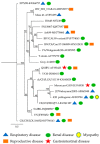Infectious Bronchitis Coronavirus Infection in Chickens: Multiple System Disease with Immune Suppression
- PMID: 32987684
- PMCID: PMC7598688
- DOI: 10.3390/pathogens9100779
Infectious Bronchitis Coronavirus Infection in Chickens: Multiple System Disease with Immune Suppression
Abstract
In the early 1930s, infectious bronchitis (IB) was first characterized as a respiratory disease in young chickens; later, the disease was also described in older chickens. The etiology of IB was confirmed later as being due to a coronavirus: the infectious bronchitis virus (IBV). Being a coronavirus, IBV is subject to constant genome change due to mutation and recombination, with the consequence of changing clinical and pathological manifestations. The potential use of live attenuated vaccines for the control of IBV infection was demonstrated in the early 1950s, but vaccine breaks occurred due to the emergence of new IBV serotypes. Over the years, various IBV genotypes associated with reproductive, renal, gastrointestinal, muscular and immunosuppressive manifestations have emerged. IBV causes considerable economic impacts on global poultry production due to its pathogenesis involving multiple body systems and immune suppression; hence, there is a need to better understand the pathogenesis of infection and the immune response in order to help developing better management strategies. The evolution of new strains of IBV during the last nine decades against vaccine-induced immune response and changing clinical and pathological manifestations emphasize the necessity of the rational development of intervention strategies based on a thorough understanding of IBV interaction with the host.
Keywords: chicken; infectious bronchitis coronavirus; molecular epidemiology; pathogenesis; tissue tropism.
Conflict of interest statement
The authors declare no conflict of interest.
Figures



References
-
- Fernando F.S., Kasmanas T.C., Lopes P.D., da Silva Montassier M.d.F., Mores M.A.Z., Mariguela V.C., Pavani C., dos Santos R.M., Assayag M.S., Jr., Montassier H.J. Assessment of molecular and genetic evolution, antigenicity and virulence properties during the persistence of the infectious bronchitis virus in broiler breeders. J. Gen. Virol. 2017;98:2470–2481. doi: 10.1099/jgv.0.000893. - DOI - PubMed
Publication types
Grants and funding
LinkOut - more resources
Full Text Sources

